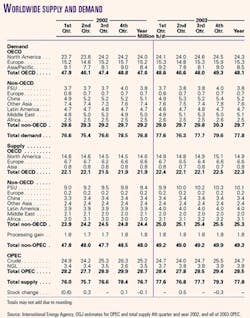The global oil market will closely observe members of the Organization of Petroleum Exporting Countries this year as they maneuver to maintain prices and market share as demand fluctuates and geopolitical tensions affect production.
In December the organization agreed to raise its output target with the goal of reducing exports this year, reasoning that higher targets would influence individual countries to more closely comply.
Effective Jan. 1, output by all members excluding Iraq was set at 23 million b/d. This is up from an output target of 21.7 million b/d that stood for all of last year. The supply of crude from OPEC, including Iraq, far exceeded this target throughout 2002 (see table), averaging an estimated 26.3 million b/d in the fourth quarter.
Efforts at restraining production received assistance in December as political turmoil in Venezuela led to a strike that shut down exports. Venezuela produced an estimated 2.7 million bbl in November, so the loss of this alone put OPEC below the new output target, at least temporarily.
Additionally, Iraqi output could be interrupted as a result of a military conflict in that country. Oil production in Iraq for December is estimated at 2.4 million b/d. In light of these events, OPEC has pledged that its other members will make up for any supply disruptions so as to prevent a shortage in world oil supply, however.
Earlier this month, the organization met again and raised output targets 1.5 million b/d effective Feb. 1.
The annual average OPEC reference basket price of crude has been relatively steady for the past 2 years, but the averages disguise month-to-month fluctuations. During 2001, the monthly average OPEC basket price went as high as $26.54/bbl for June and as low as $17.83/bbl for December. The average price for 2001 was $23.40/bbl. Last year's monthly averages were as volatile, ranging from $18.53/bbl in January to $27.80/bbl in October, and the annual average price was $24.00/bbl.
Demand
The International Energy Agency estimates that 2003 worldwide demand will average 77.8 million b/d, an increase of 1 million b/d from last year. Demand growth hinges on the health of major economies, however.
Demand in 2002 exceeded that of 2001 by a mere 300,000 b/d. All of the increase came from countries outside the Organization for Economic Cooperation and Development, and a decline in OECD demand partially offset that. Total OECD demand in 2002 declined to 47.6 million b/d from 47.7 million b/d a year earlier.
Oil demand in North America increased 100,000 b/d last year, the same amount by which it fell in Europe. European economies struggled last year, most notably the German economy—which will continue to struggle this year.
OECD Asia Pacific demand is expected to rise slightly this year following a 200,000 b/d decline last year. Fourth quarter 2002 demand picked up as a result of a rebound in petrochemical production, which spurred demand for naphtha.
China led non-OECD demand growth last year, with growth in demand for products such as LPG and asphalt as well as crude oil for larger refinery runs. IEA expects total 2003 non-OECD demand to average 29.7 million b/d, up from 29.2 million b/d last year and 28.8 million b/d the year before.
Supply
Russian oil output growth exceeded all other production gains last year. IEA estimates that production of crude, condensate, and NGL in Russia increased to 7.66 million b/d from 7.02 million b/d a year earlier. The Paris-based agency forecasts that Russian production will move up this year to average 8.21 million b/d.
IEA also projects continuing production gains in North America, Latin America, and Africa. Estimates put total 2003 non-OPEC supply at 49.3 million b/d, up from 48 million b/d last year and 2001 production of 46.6 million b/d.
OGJ estimates that 2003 OPEC crude output will average 24.7 million b/d. This would leave stocks unchanged for the year. If the 11 members of OPEC produce that amount in the first quarter, and IEA estimates of total demand and non-OPEC supply prove accurate, then oil inventories will be unchanged for the quarter.
If the organization further restrains output in the second quarter, when demand normally subsides, then stocks will build at a rate of 500,000 b/d. OGJ projects that third and fourth quarter output will pick up, finishing the year at an average 25.5 million b/d during peak demand, and inventory draws will average 300,000 b/d.

